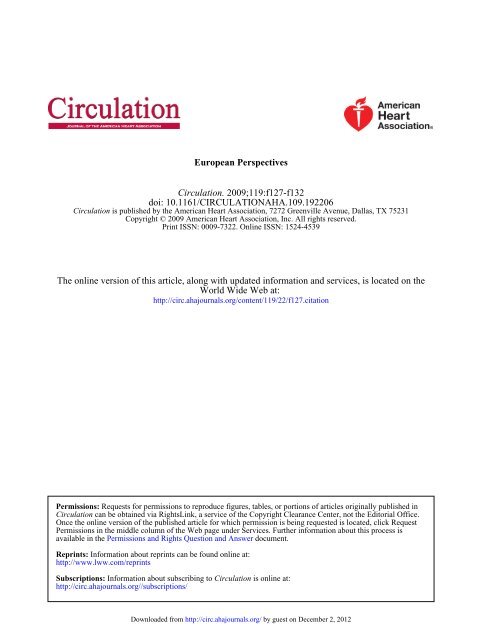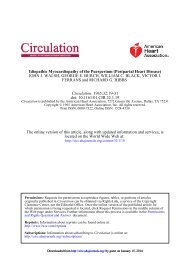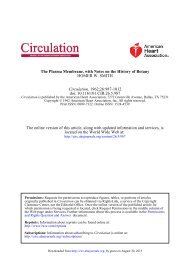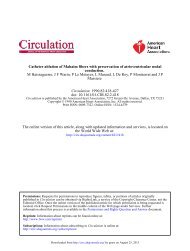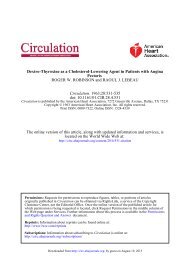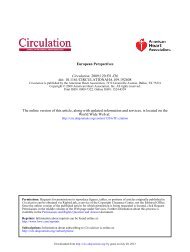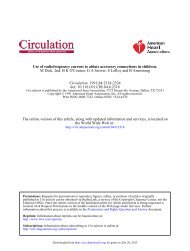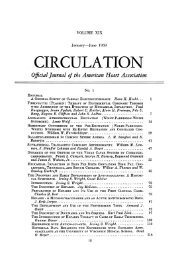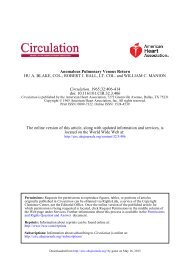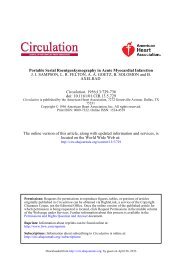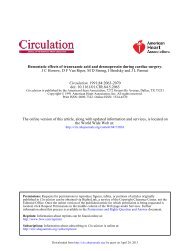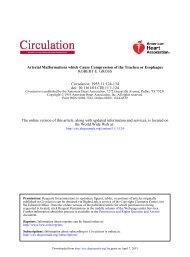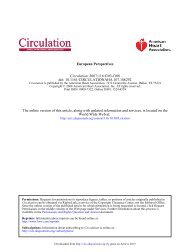Francisco Fernández-Avilés, MD, PhD, FESC, FACC - Circulation
Francisco Fernández-Avilés, MD, PhD, FESC, FACC - Circulation
Francisco Fernández-Avilés, MD, PhD, FESC, FACC - Circulation
Create successful ePaper yourself
Turn your PDF publications into a flip-book with our unique Google optimized e-Paper software.
European Perspectives<br />
<strong>Circulation</strong>. 2009;119:f127-f132<br />
doi: 10.1161/CIRCULATIONAHA.109.192206<br />
<strong>Circulation</strong> is published by the American Heart Association, 7272 Greenville Avenue, Dallas, TX 75231<br />
Copyright © 2009 American Heart Association, Inc. All rights reserved.<br />
Print ISSN: 0009-7322. Online ISSN: 1524-4539<br />
The online version of this article, along with updated information and services, is located on the<br />
World Wide Web at:<br />
http://circ.ahajournals.org/content/119/22/f127.citation<br />
Requests for permissions to reproduce figures, tables, or portions of articles originally published in<br />
<strong>Circulation</strong> can be obtained via RightsLink, a service of the Copyright Clearance Center, not the Editorial Office.<br />
Once the online version of the published article for which permission is being requested is located, click Request<br />
Permissions in the middle column of the Web page under Services. Further information about this process is<br />
available in the Permissions and Rights Question and Answer document.<br />
Permissions:<br />
Reprints: Information about reprints can be found online at:<br />
http://www.lww.com/reprints<br />
Subscriptions: Information about subscribing to <strong>Circulation</strong> is online at:<br />
http://circ.ahajournals.org//subscriptions/<br />
Downloaded from<br />
http://circ.ahajournals.org/ by guest on December 2, 2012
<strong>Circulation</strong> June 9, 2009<br />
On other pages...<br />
European Perspectives in Cardiology<br />
Spotlight: <strong>Francisco</strong> <strong>Fernández</strong>-<strong>Avilés</strong>,<br />
<strong>MD</strong>, <strong>PhD</strong>, <strong>FESC</strong>, <strong>FACC</strong><br />
Leading Translational Research With Stem Cells<br />
to Prevent and Treat Postinfarction Heart Failure<br />
<strong>Francisco</strong> <strong>Fernández</strong>-<strong>Avilés</strong>, chair of the Department of Cardiology,<br />
University Hospital Gregorio Marañón, Madrid, Spain,<br />
talks to Barry Shurlock, MA, <strong>PhD</strong>.<br />
The Department of Cardiology at the University Hospital<br />
Gregorio Marañón, Madrid, Spain, is the largest heart<br />
centre in Spain, and it plays a leading role in the studies of<br />
stem cell techniques for repairing heart tissue. Like other<br />
cardiology departments in Spain, it sends its experienced<br />
cardiologists to business school but still puts the patient at<br />
the centre, according to <strong>Fernández</strong>-<strong>Avilés</strong>, <strong>MD</strong>, <strong>PhD</strong>, <strong>FESC</strong>,<br />
<strong>FACC</strong>, chief and professor of medicine at Complutense<br />
University, Madrid, Spain.<br />
“I Decided to be a Doctor Before I Was 10 Years Old<br />
Because I Had the Experience of Seeing Close Relatives<br />
Who Were Sick”<br />
Professor <strong>Fernández</strong>-<strong>Avilés</strong> was born in Cuenca, Spain,<br />
about 50 miles (80 kilometres) from Madrid. Cuenca is a<br />
small historic town that is now a World Heritage Site and a<br />
tourist destination. His father died when he was very young,<br />
and his mother took him to live in Madrid, which almost<br />
makes him a “Madrileño.” He says, “I decided to be a doctor<br />
before I was 10 years old because I had the experience of<br />
seeing close relatives who were sick and I considered the<br />
work of medicine to be marvellous. I was the first to go to<br />
university. It was fantastic! I was very, very lucky.” He<br />
studied medicine at Complutense University and the<br />
University Hospital Gregorio Marañón.<br />
Complutense University is widely regarded as the premier<br />
university in Spain. First founded as a studium generale<br />
by a Castilian monarch at the end of the 13th century (1293),<br />
it was refounded by papal edict in the early 16th century<br />
(papal bull 1499, opened 1509). In 1836, it moved to central<br />
Madrid. Among its famous sons are Santiago Ramón y<br />
Cajal, <strong>MD</strong> (1852–1934), who won a Nobel Prize in 1906 for<br />
his work on the fine structure of the nervous system and gave<br />
his name to Cajal cells. His name is commemorated in a city<br />
centre hospital in Madrid. He also made many contributions<br />
to tumour biology, although they are little known to non-<br />
Spanish speakers. More recently, in 1959, the Nobel Prize<br />
for Medicine was shared by the Spanish physician and biochemist<br />
Severo Ochoa, <strong>MD</strong> (1905–1993). Ochoa studied in<br />
Madrid and worked in several cities in Germany and the<br />
United Kingdom before emigrating to the United States,<br />
where he studied the enzymatic mechanisms of oxidative<br />
metabolism and helped to unravel the biological synthesis of<br />
RNA and DNA.<br />
By 1990, Professor <strong>Fernández</strong>-<strong>Avilés</strong> had performed<br />
more than 1000 angioplasties and overseen 50 cases as the<br />
Centre of Excellence: Department of Cardiology,<br />
University Hospital Gregorio Marañón, Madrid, Spain<br />
<strong>Francisco</strong> <strong>Fernández</strong>-<strong>Avilés</strong>, <strong>MD</strong>, <strong>PhD</strong>, <strong>FESC</strong>, <strong>FACC</strong>, chair of the Department of Cardiology,<br />
University Hospital Gregorio Marañón, Madrid, Spain, describes the Department and its ambitious<br />
research programme with a budget of $6 million and major research projects on heart failure, coronary<br />
syndromes, cardiac valve disease, cardiovascular imaging, arrhythmias, and stem cell therapy.<br />
Page f131<br />
Downloaded from<br />
http://circ.ahajournals.org/ by guest on December 2, 2012<br />
f127<br />
<strong>Circulation</strong>: European Perspectives
f128<br />
<strong>Circulation</strong>: European Perspectives<br />
<strong>Circulation</strong> June 9, 2009<br />
Aerial view of the University Hospital Gregorio Marañón,<br />
Madrid, Spain, where Professor <strong>Fernández</strong>-<strong>Avilés</strong> is chair of<br />
the Department of Cardiology. The hospital is named after the<br />
celebrated endocrinologist, Gregorio Marañón y Posadillo, <strong>MD</strong><br />
(1887–1960), a writer, philosopher, and brilliant all-round intellectual.<br />
Photograph courtesy of Professor <strong>Fernández</strong>-<strong>Avilés</strong>.<br />
coordinator of the heart transplantation programme. In that<br />
year, at the relatively young age of 37, he was appointed to<br />
head the Department of Cardiology at the University<br />
Hospital, Valladolid, Spain, a city of half a million people<br />
and about 130 miles (200 kilometres) north of the Spanish<br />
capital. Once favoured by the Spanish court and containing<br />
one of the houses where Cervantes, the author of Don<br />
Quixote, lived, it is now the economic hub of its region and<br />
a venue for a prestigious international film festival. At the<br />
University Hospital, Valladolid, Professor <strong>Fernández</strong>-<strong>Avilés</strong>,<br />
while running his own department, was able to spread his<br />
wings and pursue influential studies of poststent restenosis and<br />
postinfarct reperfusion in general. A key platform for his work<br />
was the Institute of Heart Sciences [Instituto de Ciencias del<br />
Corazon] at Valladolid, which he created in 1998 and directed<br />
until 2006 when he took up his present appointments in<br />
Madrid. He has 160 articles in peer-reviewed journals and,<br />
from a long list of prizes, is particularly proud of the Order of<br />
Merit in Civil Health [Orden del Mérito Civil en Sanidad], the<br />
highest award of its kind in Spain, presented to him in 2004 by<br />
the Spanish Minister of Health.<br />
“Every Year in the Last 5 Years, We Have Sent About<br />
12 to 15 Cardiologists Around the Age of 40 to the<br />
Escuela Superior de Administración y Dirección de<br />
Empresas Business School in Madrid”<br />
In the early 1990s, Professor <strong>Fernández</strong>-<strong>Avilés</strong> started to win<br />
awards at the annual meetings of the Spanish Society of<br />
Cardiology—for example, “Best Abstract of the Year,”<br />
“Young Investigator Award,” and “Best Original Article” in<br />
the prestigious Revista Española de Cardiologia, the official<br />
Spanish Society of Cardiology journal, of which he was<br />
editor-in-chief for 6 years (from 1991 to 1997).<br />
In 1993, he made an unusual choice for a cardiologist—for<br />
1 week every month, he flew off to Barcelona to attend courses<br />
at the Escuela de Alta Dirección y Administración Business<br />
School to obtain a diploma in the Direction and Management<br />
of Medical Departments. He comments, “I needed it! Now<br />
the Novartis Cardiovascular Institute and the Foundation<br />
Miguel Servet (named after a Spaniard who described pulmonary<br />
circulation before William Harvey), with the advice<br />
of chiefs of the most prestigious cardiology departments in<br />
Spain, have decided to promote the teaching of business skills<br />
for cardiologists. Every year in the last 5 years, we have sent<br />
about 12 to 15 cardiologists (from throughout Spain) around<br />
the age of 40 to the Escuela Superior de Administración y<br />
Dirección de Empresas Business School in Madrid. When we<br />
started, there were many negative answers from all the potential<br />
candidates, and we had to work hard to convince them to<br />
attend. Now there is a waiting list—we get about 50 applications<br />
each year!”<br />
“More Than 70% of Patients in the World<br />
Do �ot Have Access to Primary Percutaneous<br />
Coronary Intervention”<br />
One of the most enduring legacies of Professor <strong>Fernández</strong>-<br />
<strong>Avilés</strong>’ period in Valladolid is the multicentre Spanish study<br />
group, Group for the Analysis of Acute Ischemic Heart<br />
Disease [Grupo de Análisis de la Cardiopatía Isquémica<br />
Aguda] (GRACIA), 1,2 which he founded in 1999. GRACIA<br />
has made major contributions to postinfarct reperfusion by<br />
piecing together the optimal strategy for the key therapeutic<br />
elements—thrombolysis, angiography, angioplasty, primary<br />
percutaneous coronary intervention (PCI), facilitated stenting<br />
(with thrombolysis with tenectplase and enoxaparin and<br />
thienopiridines), and conservative management.<br />
The outcomes of the GRACIA-1 trial, 1 published in the<br />
Lancet in 2004, and other data made it necessary to rewrite<br />
the European Society of Cardiology (ESC) guidelines for<br />
PCI, which were published in the European Heart Journal in<br />
2005. 3,4 According to Professor <strong>Fernández</strong>-<strong>Avilés</strong>, “More<br />
than 70% of patients in the world do not have access to<br />
primary PCI. If primary angioplasty cannot be done, postthrombolysis<br />
PCI is mandatory. The logistics of acute<br />
myocardial infarction (AMI) therapy with PCI is being further<br />
studied with GRACIA-3, which is now complete and<br />
has compared restenosis with a paclitaxel-eluting stent versus<br />
a bare stent; it has also determined the effect of the<br />
antiplatelet agent, tirofiban, administered before PCI but<br />
after thrombolysis.” GRACIA-4 will study what Professor<br />
<strong>Fernández</strong>-<strong>Avilés</strong> calls “the following day strategy” or “rescue<br />
PCI” in cases without evidence of reperfusion after lysis.<br />
“In 2001, I Founded the Terapia Celular Aplicada al<br />
Miocardio Group to Develop Translational Research<br />
With Stem Cells to Prevent and Treat<br />
Postinfarction Heart Failure”<br />
Professor <strong>Fernández</strong>-<strong>Avilés</strong>’ experimental and clinical<br />
studies on ischaemia and reperfusion now span more than 25<br />
years. For much of that time, he has sought to reduce<br />
mortality after myocardial infarction by what he calls (in an<br />
article presented at the ESC Congress in 2005) “definitive<br />
Downloaded from<br />
http://circ.ahajournals.org/ by guest on December 2, 2012
<strong>Circulation</strong> June 9, 2009<br />
1994 team photograph of the<br />
Department of Cardiology,<br />
University Hospital, Valladolid.<br />
Professor <strong>Fernández</strong>-<strong>Avilés</strong> was<br />
appointed head of the Department<br />
in 1990. Left to right, top<br />
row: Dr Enrique Guillén; Juan<br />
Carlos Muñoz; Dr Luis de la<br />
Fuente; middle row: Dr Benigno<br />
Ramos; Dr Joaquín Alonso; Dr<br />
Jerónimo Rubio; Professor<br />
<strong>Fernández</strong>-<strong>Avilés</strong>; Dr Zulema<br />
Sainz (fellow from Bolivia); Dr<br />
Lolita Diurzaeva (fellow from<br />
Russia); bottom row: Dr Jose<br />
Luis Vega; Dr José Bermejo; Dr<br />
Federico Gimeno; Dr Justo<br />
Torres; Dr Miguel Casado.<br />
Photo courtesy of Professor<br />
<strong>Fernández</strong>-<strong>Avilés</strong>.<br />
mechanical repair of the culprit artery,” but more recently he<br />
has focused on postinfarct sequelae. He explains, “I realised<br />
after GRACIA-2 2 and other trials that reperfusion after AMI<br />
is not enough, and we must now consider how to improve<br />
left-ventricular function after an infarct. Even with optimal<br />
PCI and thrombolysis, many patients will develop heart failure<br />
and die. My main interest now, after the mechanical<br />
approach [of reperfusion] has done what it can for the patient<br />
acutely, is to use biological strategies [such as the use of<br />
stem cells] to avoid heart failure. The future of cardiology is<br />
the chronic patient because we are doing very well in the<br />
acute setting, but [in the process] are creating many, many<br />
chronic patients!”<br />
One of the key events of Professor <strong>Fernández</strong>-<strong>Avilés</strong>’<br />
time at Valladolid was his creation, in 2001, of the Stem<br />
Cell Therapy for Myocardial Repair [Terapia Celular<br />
Aplicada al Miocardio] (TECAM) project. He recalls, “In<br />
2001, I founded the TECAM group to develop translational<br />
research with stem cells to prevent and treat postinfarction<br />
heart failure. 5 We have a number of AMI trials ongoing,<br />
including 1 with 4 arms, comparing autologous mononuclear<br />
bone marrow transplantation, resynchronisation, or<br />
both, with conventional reperfusion therapy. For the more<br />
difficult scenario of chronic myocardial infarction, the<br />
PRECISE (adiPose-deRived stEm Cells In the treatment<br />
of patients with non revaScularisable ischaEmic<br />
myocardium) trial is currently in progress. This is a doubleblind,<br />
randomised clinical trial of adipose-derived stem and<br />
regenerative cells in the treatment of patients with nonrevascularisable<br />
ischaemic myocardium. Adipose-derived<br />
stem and regenerative cells will be injected into the left<br />
ventricle and the outcomes of safety and feasibility will be<br />
measured. The position and function of these cells will be<br />
guided and assessed with a variety of imaging modalities,<br />
including electromagnetic mapping with NOGA, magnetic<br />
resonance imaging, single photon emission computed<br />
tomography, and echocardiography.”<br />
“Good Opportunities for the Use of Stem Cells in the<br />
Myocardium, and for AMI There Is Already Enough<br />
Evidence to Perform Large-Scale Clinical Trials”<br />
In 2003, after TECAM, Professor <strong>Fernández</strong>-<strong>Avilés</strong>, on his<br />
own initiative, held the first International Symposium on<br />
Stem Cell Therapy and Cardiovascular Innovations<br />
(http://www.cardiovascularcelltherapy.com), which has<br />
become an annual fixture in Madrid and is attended by about<br />
400 specialists from around the world, with a strong faculty<br />
from Europe and the United States. In 2004, buoyed up with<br />
the success of the first symposium and keen to spread news<br />
of a new area of cardiovascular research, Professor<br />
<strong>Fernández</strong>-<strong>Avilés</strong> presented a key lecture to delegates at the<br />
ESC Congress in Munich, Germany, titled, “Cell<br />
Therapy—The Genie Is Out of the Bottle.” Four years later,<br />
in 2008, the message had moved on. When he addressed the<br />
4th International Symposium on Stem Cell Therapy, held in<br />
New York, NY, his lecture was titled, “Reconstructing the<br />
Heart—Strategies for the Next Decade. Adipose-Derived<br />
Cells for Chronic Myocardial Infarction.”<br />
Commenting on the use of stem cells in cardiac repair,<br />
Professor <strong>Fernández</strong>-<strong>Avilés</strong> says, “There are good opportunities<br />
for the use of stem cells in the myocardium, and for<br />
AMI there is already enough evidence to perform largescale<br />
clinical trials. Several centres in Germany are almost<br />
ready to start, although it will take 5 years before we have<br />
any results. For chronic disease, we need to reinnervate<br />
cardiac muscle, and for that we need very plastic stem<br />
cells, such as induced pluripotent stem cells. However,<br />
there are safety issues, principally the prevention of<br />
tumours, which will have to be addressed before we can<br />
consider clinical use.”<br />
“Leading the Way Forward”<br />
Since 2000, Professor <strong>Fernández</strong>-<strong>Avilés</strong> has served the<br />
ESC in a variety of positions. He holds a silver medal of the<br />
society and served as a vice-president between 2002 and<br />
Downloaded from<br />
http://circ.ahajournals.org/ by guest on December 2, 2012<br />
f129<br />
<strong>Circulation</strong>: European Perspectives
f130 <strong>Circulation</strong> June 9, 2009<br />
<strong>Circulation</strong>: European Perspectives<br />
Photograph of participants at the first meeting on February 7, 2007, of the Spanish Cooperative Cardiovascular Disease Research �etwork<br />
(RECAVA). Professor <strong>Fernández</strong>-<strong>Avilés</strong> is the chair of RECAVA, which is run by the Spanish Ministry for Science and Innovation and integrates<br />
about 700 researchers and 50 basic and clinical research groups from around Spain. Photograph courtesy of Professor <strong>Fernández</strong>-<strong>Avilés</strong>.<br />
2004. He is editor-in-chief of European Heart Journal<br />
supplements, a member of working groups on coronary circulation<br />
as well as thrombosis and platelets, and also part of<br />
the ESC Task Force on Stem Cells and Repair of the Heart,<br />
founded in 2004. He says, “One of the main purposes of the<br />
task force is to make proposals on the methodology of<br />
clinical research with stem cells, to consider the types of<br />
cardiovascular studies that need to be carried out, and to<br />
define the types of end points that need to be achieved.” He<br />
also belongs to the ESC European Relations Committee and<br />
has been charged with writing a “White Paper” on cardiovascular<br />
research for presentation to the European Union.<br />
His national commitments have also grown. In addition to<br />
chairing the Spanish Cooperative Cardiovascular Disease<br />
Research Network [Red Temática de Investigación<br />
Cooperativa en Enfermedades Cardiovasculares], which is<br />
run by the Spanish Ministry for Science and Innovation and<br />
integrates about 700 researchers and 50 basic and clinical<br />
research groups from around the country, he advises the<br />
Spanish government on national plans for cardiology in general,<br />
including biomedical research, cardiac transplantation,<br />
catheterisation laboratories, and other matters. He is a member<br />
of the Spanish National Commission for the Specialty of<br />
Cardiovascular Medicine and a board member of the Centre<br />
for Transplants and Regenerative Medicine [Centro de<br />
Transplantes y Medicina Regenerativa].<br />
In addition, Professor <strong>Fernández</strong>-<strong>Avilés</strong> has been active at<br />
the European level as a member of the European Union<br />
Health Research Advisory Group, setting priorities for the<br />
7th Framework Programme for Research and Technological<br />
Development, which runs to 2013. He is also a board member<br />
of the International Society for Cardiovascular<br />
Translational Research, created in 2007.<br />
Professor <strong>Fernández</strong>-<strong>Avilés</strong> has a busy life. During the<br />
summer, he spends time catching up with his family, who<br />
gather at Cadiz in the Adalusian region of Spain, where he<br />
has a second home. Here he can indulge his passion for<br />
natural history (Darwin is one of his heroes). He says, “In<br />
my spare time, I love to read─and sometimes I play golf. I<br />
am really bad─my handicap is 24!”<br />
References<br />
1. <strong>Fernández</strong>-<strong>Avilés</strong> F, Alonso J, Castro-Beiras A, Vázquez N, Blanco J,<br />
Alonso-Briales J, López-Messa J, <strong>Fernández</strong> Vazquez F, Calvo I, Martínez-<br />
Elbal L, San Román A, Ramos B. Routine invasive strategy within 24 hours<br />
of thrombolysis versus ischaemia-guided conservative approach for acute<br />
myocardial infarction with ST-segment elevation (GRACIA-1): a randomised<br />
controlled trial. Lancet. 2004 ;364:1045–1054.<br />
2. Fernandez-Aviles F, Alonso J, Peña G, Blanco J, Alonso-Briales J, López-<br />
Messa J, Fernandez-Vázquez F, Moreu J, Hernández R, Castro-Beiras A,<br />
Gabriel R, Sanchez PL. Primary angioplasty versus early routine post-fibrinolysis<br />
angioplasty for acute myocardial infarction with ST-segment elevation:<br />
the GRACIA 2 non-inferiority, randomised, controlled trial. Eur<br />
Heart J. 2007;28:949–960.<br />
3. Thygesen K, Alpert JS, White HD; Joint ESC/ACCF/AHA/WHF Task<br />
Force for the Redefinition of Myocardial Infarction, Jaffe AS, Apple FS,<br />
Galvani M, Katus HA, Newby LK, Ravkilde J, Chaitman B, Clemmensen<br />
PM, Dellborg M, Hod H, Porela P, Underwood R, Bax JJ, Beller GA,<br />
Bonow R, Van der Wall EE, Bassand JP, Wijns W, Ferguson TB, Steg PG,<br />
Uretsky BF, Williams DO, Armstrong PW, Antman EM, Fox KA, Hamm<br />
CW, Ohman EM, Simoons ML, Poole-Wilson PA, Gurfinkel EP, Lopez-<br />
Sendon JL, Pais P, Mendis S, Zhu JR, Wallentin LC, <strong>Fernández</strong>-<strong>Avilés</strong> F,<br />
Fox KM, Parkhomenko AN, Priori SG, Tendera M, Voipio-Pulkki LM,<br />
Vahanian A, Camm AJ, De Caterina R, Dean V, Dickstein K, Filippatos G,<br />
Funck-Brentano C, Hellemans I, Kristensen SD, McGregor K, Sechtem<br />
U, Silber S, Tendera M, Widimsky P, Zamorano JL, Morais J, Brener S,<br />
Harrington R, Morrow D, Lim M, Martinez-Rios MA, Steinhubl S, Levine<br />
GN, Gibler WB, Goff D, Tubaro M, Dudek D, Al-Attar N.Universal definition<br />
of myocardial infarction. <strong>Circulation</strong>. 2007;116:2634–2653.<br />
4. Task Force for Diagnosis and Treatment of Non-ST-Segment Elevation<br />
Acute Coronary Syndromes of European Society of Cardiology, Bassand<br />
JP, Hamm CW, Ardissino D, Boersma E, Budaj A, <strong>Fernández</strong>-<strong>Avilés</strong> F, Fox<br />
KA, Hasdai D, Ohman EM, Wallentin L, Wijns W. Guidelines for the diagnosis<br />
and treatment of non-ST-segment elevation acute coronary syndromes.<br />
Eur Heart J. 2007;28:1598–1660.<br />
5. <strong>Fernández</strong>-<strong>Avilés</strong> F, San Roman A, García-Frade J, <strong>Fernández</strong> ME.<br />
Peñarrubia MJ, de la Fuente L, Gómez-Bueno M, Cantalapiedra A,<br />
<strong>Fernández</strong> J, Gutierrez O, Sanchez P.L, Hernández C, Sanz R, García-Sancho<br />
J, Sanchez A. Experimental and clinical regenerative capability of human<br />
bone marrow cells after myocardial infarction. Circ Res. 2004 ;95:742–748.<br />
Barry Shurlock is a freelance medical journalist.<br />
Downloaded from<br />
http://circ.ahajournals.org/ by guest on December 2, 2012
<strong>Circulation</strong> June 9, 2009<br />
Centre of Excellence: Department of Cardiology,<br />
University Hospital Gregorio Marañón,<br />
Madrid, Spain<br />
An Ambitious Research Programme with a Budget of $6 Million and Major<br />
Research Projects on Heart Failure, Coronary Syndromes, Cardiac Valve Disease,<br />
Cardiovascular Imaging, Arrhythmias, and Stem Cell Therapy<br />
<strong>Francisco</strong> <strong>Fernández</strong>-<strong>Avilés</strong>, <strong>MD</strong>, <strong>PhD</strong>, <strong>FESC</strong>, <strong>FACC</strong>, chair of the Department of Cardiology,<br />
University Hospital Gregorio Marañón, Madrid, Spain, describes the Department and its work to<br />
Barry Shurlock, MA, <strong>PhD</strong>.<br />
Team photo May 2007. Department of Cardiology. University Hospital Gregorio Marañón, Madrid, Spain. The Department of Cardiology<br />
has 4 divisions—clinical, noninvasive, invasive, and research, innovation, and education—with a medical staff of 30, about 25 fellows<br />
and newly qualified specialists, and an ever-changing contingent of about 20 visiting researchers. Photograph courtesy of Professor<br />
<strong>Fernández</strong>-<strong>Avilés</strong>.<br />
In Madrid, <strong>Francisco</strong> <strong>Fernández</strong>-<strong>Avilés</strong>, <strong>MD</strong>, <strong>PhD</strong>, <strong>FESC</strong>,<br />
<strong>FACC</strong>, runs a large Department of Cardiology at the<br />
University Hospital Gregorio Marañón, Madrid, Spain.<br />
With origins in 1567, when King Phillip II founded the<br />
hospital, it now belongs to the Public Heath Service of<br />
Madrid and receives more than 65000 admissions a year in<br />
all departments. Every year, more than 35000 cardiac<br />
patients pass through the 7 outpatient clinics, and more<br />
than 5000 are admitted to the 51-bed cardiology ward<br />
and/or the 11-bed coronary care unit. They are served by 4<br />
catheterisation laboratories, 2 focused on intervention plus<br />
another for electrophysiology and a multifunction laboratory.<br />
A large imaging centre with 11 echocardiographs produces<br />
more than 20000 scans (echos) each year. The department<br />
performs nearly 1000 electrophysiology studies a year, of<br />
which about 75% are therapeutic.<br />
Despite a considerable administrative load, Professor<br />
<strong>Fernández</strong>-<strong>Avilés</strong> manages to spend about half his time with<br />
patients or doing research. He explains, “I love my department!<br />
I am an interventional cardiologist and I love it! But I<br />
also love to be close to the patient and receive input from the<br />
patient. I believe that everything should be based on the<br />
patient. I am not fond of administration—but it’s very important:<br />
If you want to improve the situation of patients, staff,<br />
Downloaded from<br />
http://circ.ahajournals.org/ by guest on December 2, 2012<br />
f131<br />
<strong>Circulation</strong>: European Perspectives
f132 <strong>Circulation</strong> June 9, 2009<br />
<strong>Circulation</strong>: European Perspectives<br />
An endovascular percutaneous implantation of a prosthetic aortic<br />
valve perfomed by Professor <strong>Fernández</strong>-<strong>Avilés</strong> at the Department<br />
of Cardiology at the University Hospital Gregorio Marañón,<br />
Madrid, January 31, 2009. This type of procedure, which is performed<br />
using a simple groin puncture and local anaesthesia,<br />
avoids the need for open heart surgery and has revolutionised the<br />
field of cardiac valve replacement. Photograph courtesy of<br />
Professor <strong>Fernández</strong>-<strong>Avilés</strong>.<br />
fellows, and students, you must fight for it, and that means<br />
lots of administration! To achieve goals, you need to spend<br />
time—you have to have a meeting, then another meeting,<br />
and another. So, although one very important focus is the<br />
patient, the other is the team. As ‘the boss,’ you need to create<br />
a framework and have goals, and you need to be firm.<br />
But you also need to allow people to ‘roam’ with freedom, to<br />
be free and autonomous, otherwise the team will fragment.”<br />
“Working in Another Country Is Essential”<br />
Professor <strong>Fernández</strong>-<strong>Avilés</strong> clearly values working abroad,<br />
although he never managed to do so himself. In 1982, after<br />
completing his <strong>PhD</strong>, he planned to work at the Montreal<br />
Heart Institute, Quebec, Canada, but his plans were thwarted<br />
when his mother fell ill and he decided to stay home. He comments,<br />
“For young cardiologists, working in another country<br />
is essential. It’s almost obligatory for my young fellows to go<br />
abroad. They normally come back and then try to incorporate<br />
the knowledge they have gained into their clinical practice.<br />
But it’s not only for clinical and scientific knowledge that<br />
they go─they also get new ideas on life and culture.”<br />
In line with this philosophy, the Department of<br />
Cardiology has close relations with a number of major institutions,<br />
including the Mayo Clinic, Rochester, Minn, the<br />
Mount Sinai Heart Centre, New York, NY, and the Texas<br />
Editor: Helmut Drexler, <strong>MD</strong>, <strong>FESC</strong><br />
Managing Editor: Lindy van den Berghe, BMedSci, BM, BS<br />
We welcome comments. E-mail lindy@circulationjournal.org<br />
Heart Institute, Houston, Tex. It also runs a “Meet With the<br />
Cardiovascular Experts” programme, where senior specialists<br />
from top cardiac centres in the world spend 2 days every<br />
month in the University Hospital Gregorio Marañón giving<br />
lectures and sharing their experiences with staff members.<br />
“We Are Focusing on Translational Research”<br />
The Department of Cardiology has an ambitious research<br />
programme with a budget of $6 million and major research<br />
projects on heart failure, coronary syndromes, cardiac<br />
valve disease, cardiovascular imaging, arrhythmias, and<br />
stem cell therapy. 1–3<br />
All cardiovascular interventions are performed, including<br />
heart transplantations, left-ventricular support procedures,<br />
and stem cell therapy. Emphasising that the Department of<br />
Cardiology has one of the largest cardiovascular caseloads in<br />
the whole of Spain, Professor <strong>Fernández</strong>-<strong>Avilés</strong> says, “We<br />
want to cure, so we need to know more. In other words, in<br />
our research the idea is to put the patient at the centre of the<br />
work, both in clinical and basic studies. We are focusing on<br />
translational research, trying to reduce the impact of the<br />
main cardiovascular pathologies through biomedical innovation.WearepartofanorganisationofwhichIamthe<br />
national chair, namely, the Spanish Cooperative<br />
Cardiovascular Disease Research Network [Red Temática de<br />
Investigación Cooperativa en Enfermedades Cardiovasculares],<br />
which is run by the Spanish Ministry for<br />
Science and Innovation and integrates about 700 researchers<br />
and 50 basic and clinical research groups from around the<br />
country. We are mainly concerned with heart failure,<br />
ischaemic heart disease, and arrhythmias—trying to improve<br />
knowledge and therapy. Our main research areas include<br />
molecular biology, imaging, stem cell therapy, and electrophysiology.<br />
A major priority is to reduce the detrimental<br />
impact of myocardial infarction on left-ventricular function by<br />
reperfusion, myocardial protection, and stem cell therapy.”<br />
References<br />
1. Cortina C, Bermejo J, Yotti R, Desco MM, Rodríguez-Pérez D, Antoranz<br />
JC, Rojo-Alvarez JL, Garcia D, García-<strong>Fernández</strong> MA, <strong>Fernández</strong>-<strong>Avilés</strong><br />
F. Noninvasive assessment of the right ventricular filling pressure gradient.<br />
<strong>Circulation</strong>. 2007;116:1015–1023.<br />
2. Bratos-Pérez MA, Sánchez PL, García de Cruz S, Villacorta E, Palacios<br />
IF, <strong>Fernández</strong>-<strong>Fernández</strong> JM, Di Stefano S, Orduña-Domingo A,<br />
Carrascal Y, Mota P, Martín-Luengo C, Bermejo J, San Roman JA,<br />
Rodríguez-Torres A, <strong>Fernández</strong>-<strong>Avilés</strong> F; Grupo AORTICA (Grupo de<br />
Estudio de la Estenosis Aórtica). Association between self-replicating<br />
calcifying nanoparticles and aortic stenosis: a possible link to valve calcification.<br />
Eur Heart J. 2008;29:371–376.<br />
3. Datino T, Almendral J, González-Torrecilla E, Atienza F, García-<strong>Fernández</strong><br />
FJ, Arenal A, Atea L, <strong>Fernández</strong>-<strong>Avilés</strong> F.Rate-related changes in QRS<br />
morphology in patients with fixed bundle branch block: implications for<br />
differential diagnosis of wide QRS complex tachycardia. Eur Heart J.<br />
2008;29:2351–2358.<br />
Barry Shurlock is a freelance medical journalist.<br />
The opinions expressed in <strong>Circulation</strong>: European Perspectives<br />
in Cardiology are not necessarily those of the editors or of<br />
the American Heart Association.<br />
Downloaded from<br />
http://circ.ahajournals.org/ by guest on December 2, 2012


